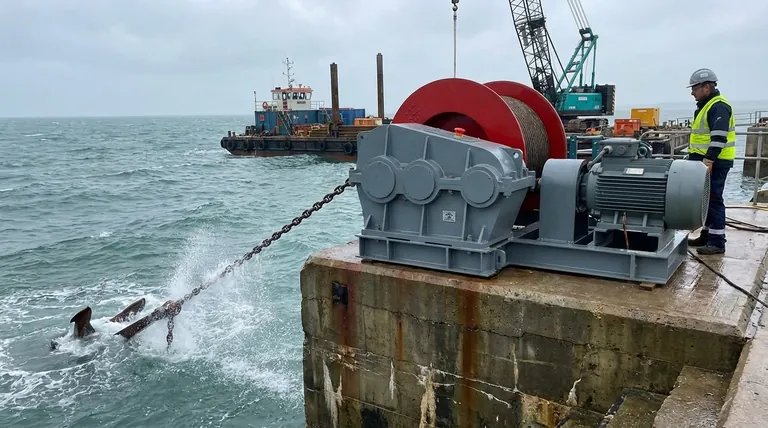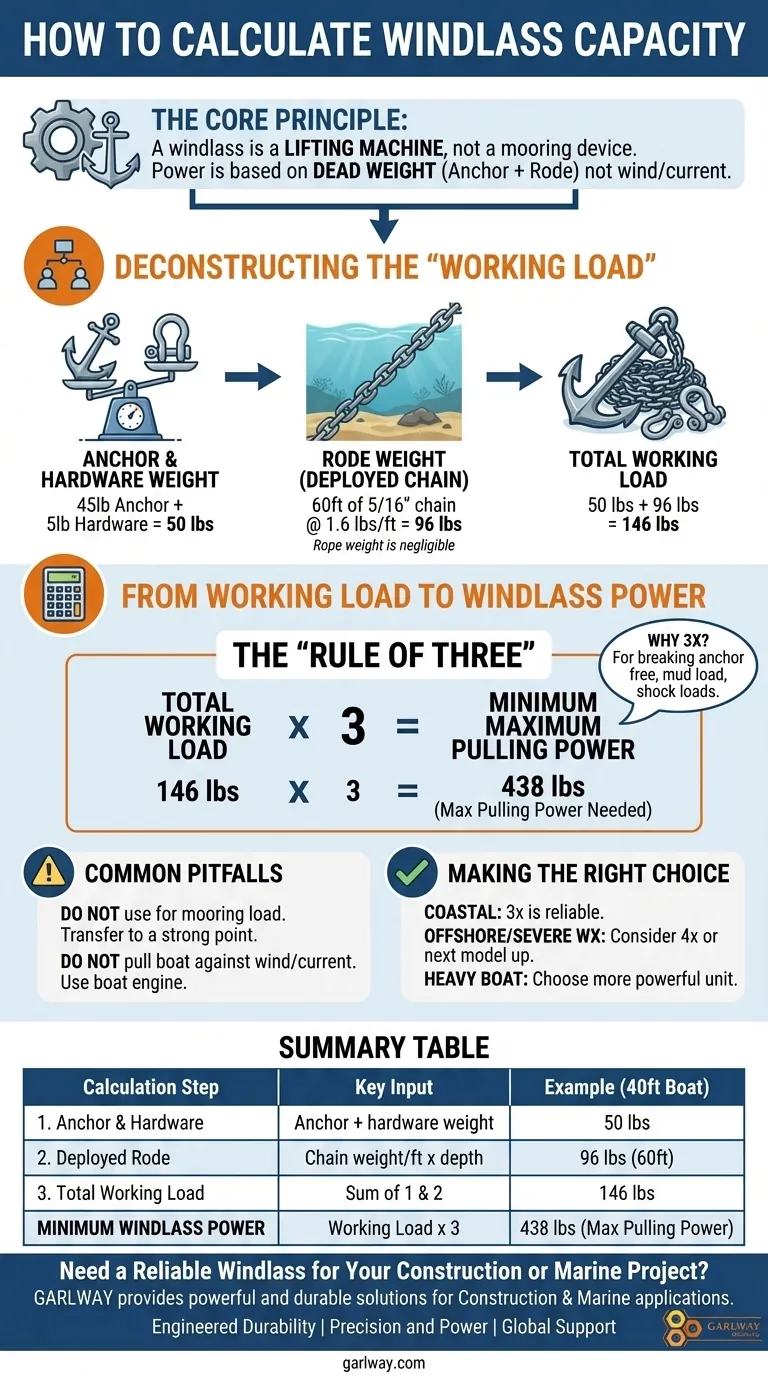To calculate windlass capacity, you must first determine your total ground tackle weight and then multiply that figure by three. This total weight, also known as the working load, is the sum of your anchor's weight plus the weight of all the chain or rope rode you have deployed. The resulting number gives you the minimum maximum pulling power your windlass should have.
The core principle is this: A windlass is a lifting machine, not a mooring device. Its required power is based on the dead weight of your anchor and rode, not the forces of wind and current acting on your boat.

Deconstructing the "Working Load"
To find the right windlass, you must first accurately calculate the total weight it will be expected to lift from the seabed vertically. This is your system's "working load."
Step 1: Anchor and Hardware Weight
This is the most straightforward part of the calculation. Simply add the weight of your anchor and any connecting hardware like shackles or swivels.
For example, a 45 lb anchor with 5 lbs of hardware equals a base weight of 50 pounds.
Step 2: Rode Weight
The weight of your rode is a critical and often underestimated factor. The calculation differs significantly between chain and rope.
- All-Chain Rode: This is the heaviest scenario. Find your chain's weight per foot and multiply it by your typical anchoring depth. For a 40-foot boat, a common depth might be 50-70 feet.
- Rope/Chain Combo: Calculate the weight of the chain portion you typically deploy. The weight of submerged rope rode is generally negligible for this calculation.
For example, 200 feet of 5/16" G4 chain weighs approximately 1.6 lbs per foot. If you anchor in 60 feet of water, the chain weight is 60 ft * 1.6 lbs/ft = 96 pounds.
Step 3: Total Ground Tackle Weight
Combine the anchor/hardware weight and the deployed rode weight to find your total working load.
Using our example: 50 lbs (anchor) + 96 lbs (chain) = 146 pounds of total working load.
From Working Load to Windlass Power
Once you have your total ground tackle weight, you can determine the necessary power rating for the windlass itself.
The "Rule of Three"
The industry standard is to select a windlass with a maximum pulling power (sometimes called max load or stall load) that is at least three times your calculated working load.
Continuing our example: 146 lbs (working load) * 3 = 438 pounds.
Therefore, you should look for a windlass with a rated maximum pulling power of at least 438 pounds.
Why the 3x Safety Factor?
This multiplier isn't arbitrary. It provides the necessary power reserve to overcome real-world conditions beyond just lifting dead weight, such as:
- Breaking the anchor free from a muddy or rocky bottom.
- Handling the added load of mud or clay stuck to the anchor and chain.
- Absorbing the shock loads from waves or swell during retrieval.
Common Pitfalls and Critical Misconceptions
Understanding what a windlass is—and what it isn't—is fundamental to boat safety.
A Windlass Lifts, It Doesn't Anchor
The single most critical mistake is using the windlass to bear the anchoring load. A windlass is designed for retrieval only.
Once the anchor is set, the load must be transferred from the windlass to a strong point on the boat, such as a Sampson post or a mooring cleat, typically using a rope snubber or chain stopper.
Pulling the Boat Forward
Never use the windlass to pull the boat up to the anchor against significant wind or current. This puts immense strain on the motor and gears. Always use your boat's engine to motor forward slowly, taking up the slack with the windlass as you go.
Confusing "Working Load" vs. "Maximum Pull"
Manufacturers use different terms. The "Working Load Limit" (WLL) is the continuous load the windlass can handle. The "Maximum Pulling Power" is the brief, peak load it can sustain to break the anchor free. Your 3x calculation gives you the target for the maximum pulling power.
Making the Right Choice for Your Goal
Use your calculated requirement as a baseline and adjust for your specific needs.
- If your primary focus is coastal cruising in moderate conditions: The "Rule of Three" is a reliable and safe guide for selecting a windlass.
- If your primary focus is offshore passage-making or anchoring in severe weather: Consider a more conservative 4x multiplier or simply choose the next model up for a greater margin of safety.
- If your boat has significant windage or weight: Error on the side of a more powerful unit, as retrieving an anchor in a blow will be more challenging.
Choosing the right windlass is a direct investment in your safety and peace of mind on the water.
Summary Table:
| Calculation Step | Key Input | Example for a 40ft Boat |
|---|---|---|
| 1. Anchor & Hardware | Weight of anchor + shackles/swivels | 50 lbs |
| 2. Deployed Rode | Weight per foot of chain x depth | 96 lbs (60ft of 5/16" chain) |
| 3. Total Working Load | Sum of Step 1 and Step 2 | 146 lbs |
| Minimum Windlass Power | Working Load x 3 (Safety Factor) | 438 lbs Maximum Pulling Power |
Need a Reliable Windlass for Your Construction or Marine Project?
Choosing the right equipment is critical for safety and efficiency, whether on a boat or a job site. At GARLWAY, we specialize in robust machinery built for demanding conditions.
We provide powerful and durable solutions for:
- Construction Companies & Contractors requiring reliable winches, concrete mixers, and batching plants.
- Marine and Industrial Applications needing heavy-duty lifting and pulling equipment.
Partner with GARLWAY to benefit from:
- Engineered Durability: Our equipment is built to handle heavy working loads and harsh environments.
- Precision and Power: Get the right capacity for your specific project requirements.
- Global Support: We serve clients worldwide with trusted machinery and service.
Get a custom solution for your project needs. Contact our experts today for a consultation!
Visual Guide

Related Products
- Heavy Duty Electric Boat Winch Windlass Anchor
- Warn Winch Windlass Boat Trailer Winch
- Electric Hoist Winch Boat Anchor Windlass for Marine Applications
- Ready Mixer Machine for Construction Ready Mix Machinery
- Portable Cement Mixer with Lift Concrete Machine
People Also Ask
- Do you have to tie off a windlass anchor? Why It's Essential for Boat Safety
- What is the difference between anchor windlass and mooring winch? Essential Guide for Marine Equipment
- How does the anchor windlass operation sequence work? Master Safe & Controlled Anchor Handling
- What is the general user satisfaction with boat anchor winches? A Game-Changer for Boaters
- How do electric boat winches work? Unlock Effortless Launching & Retrieval



















